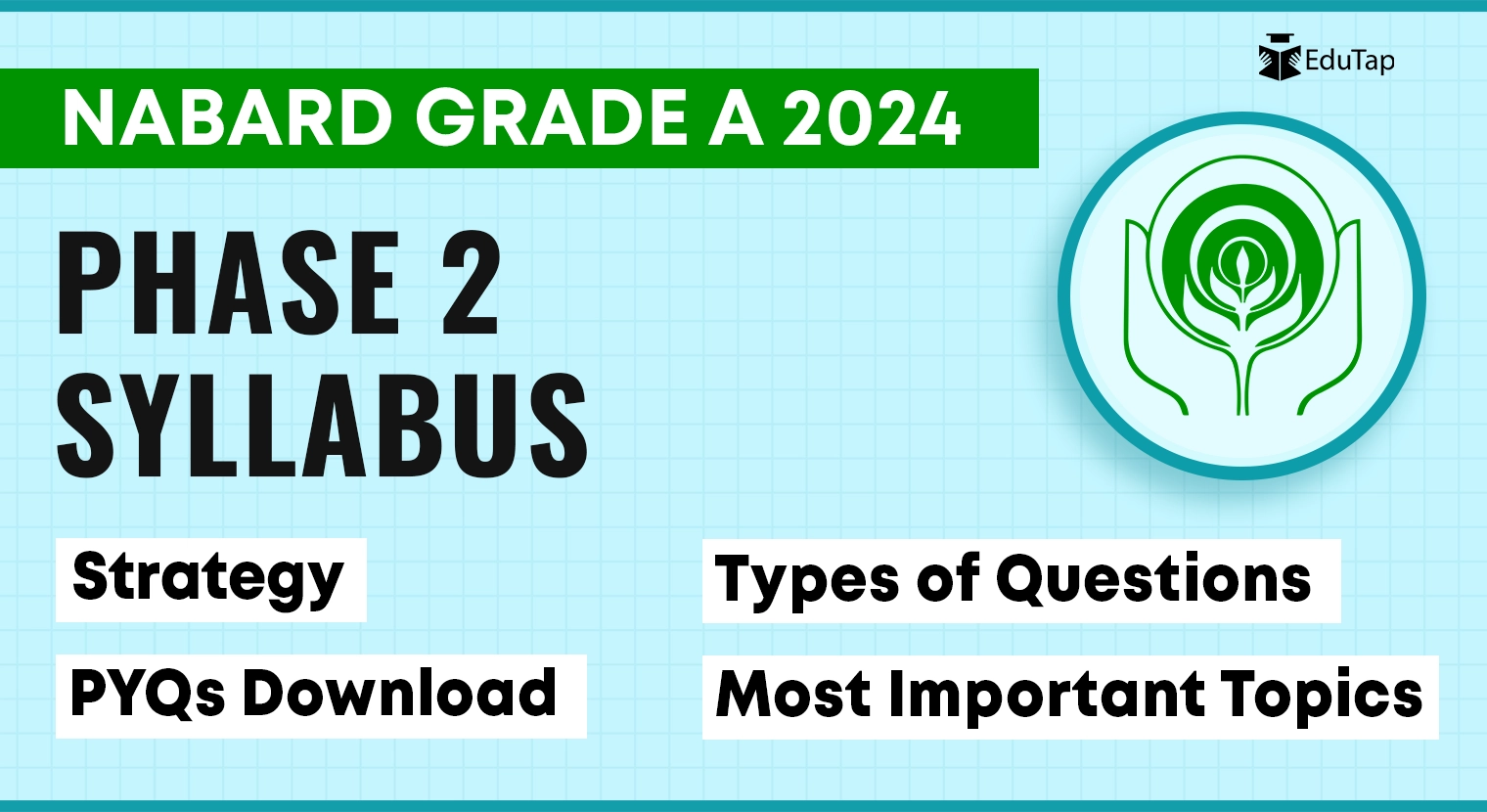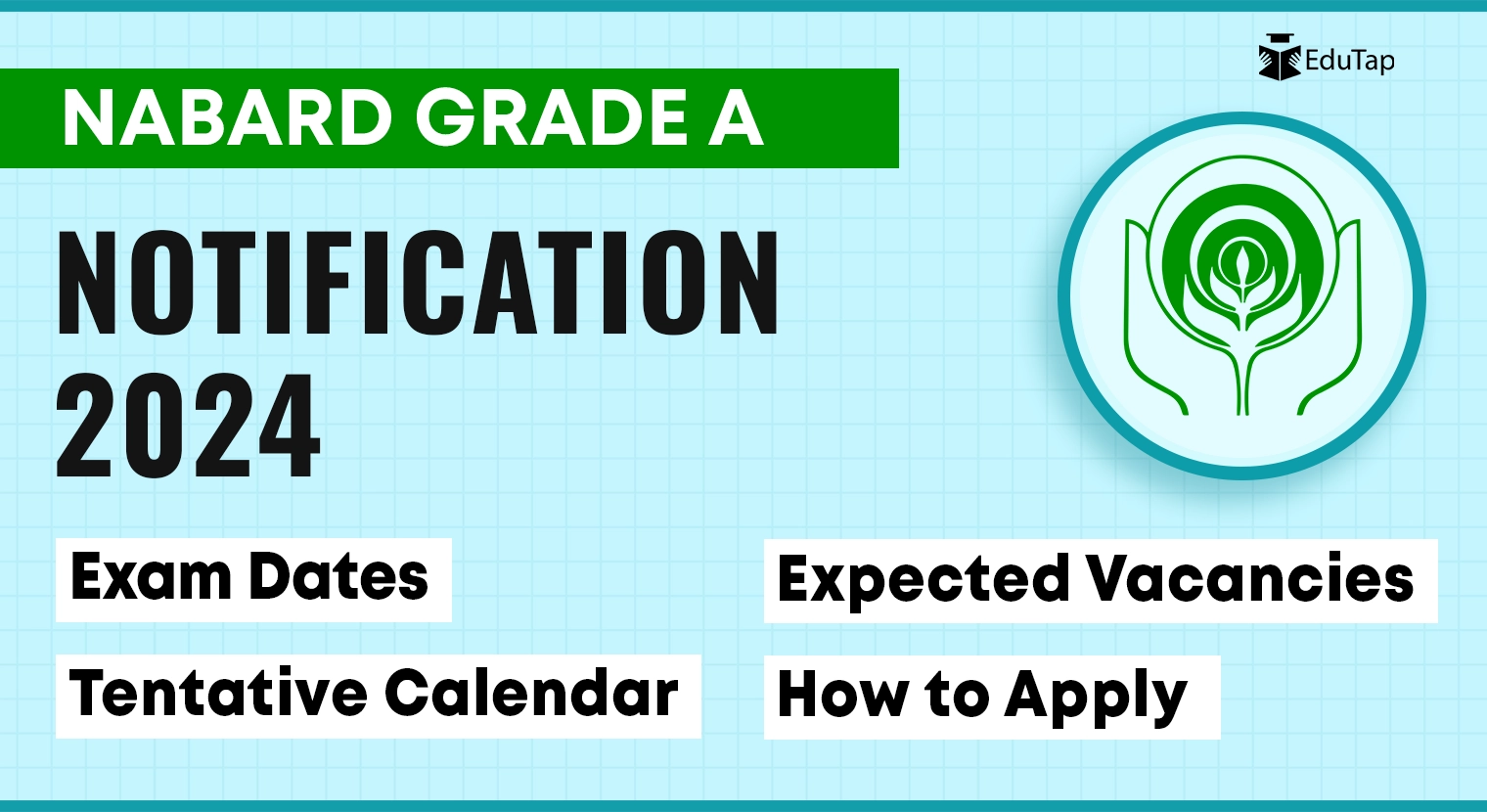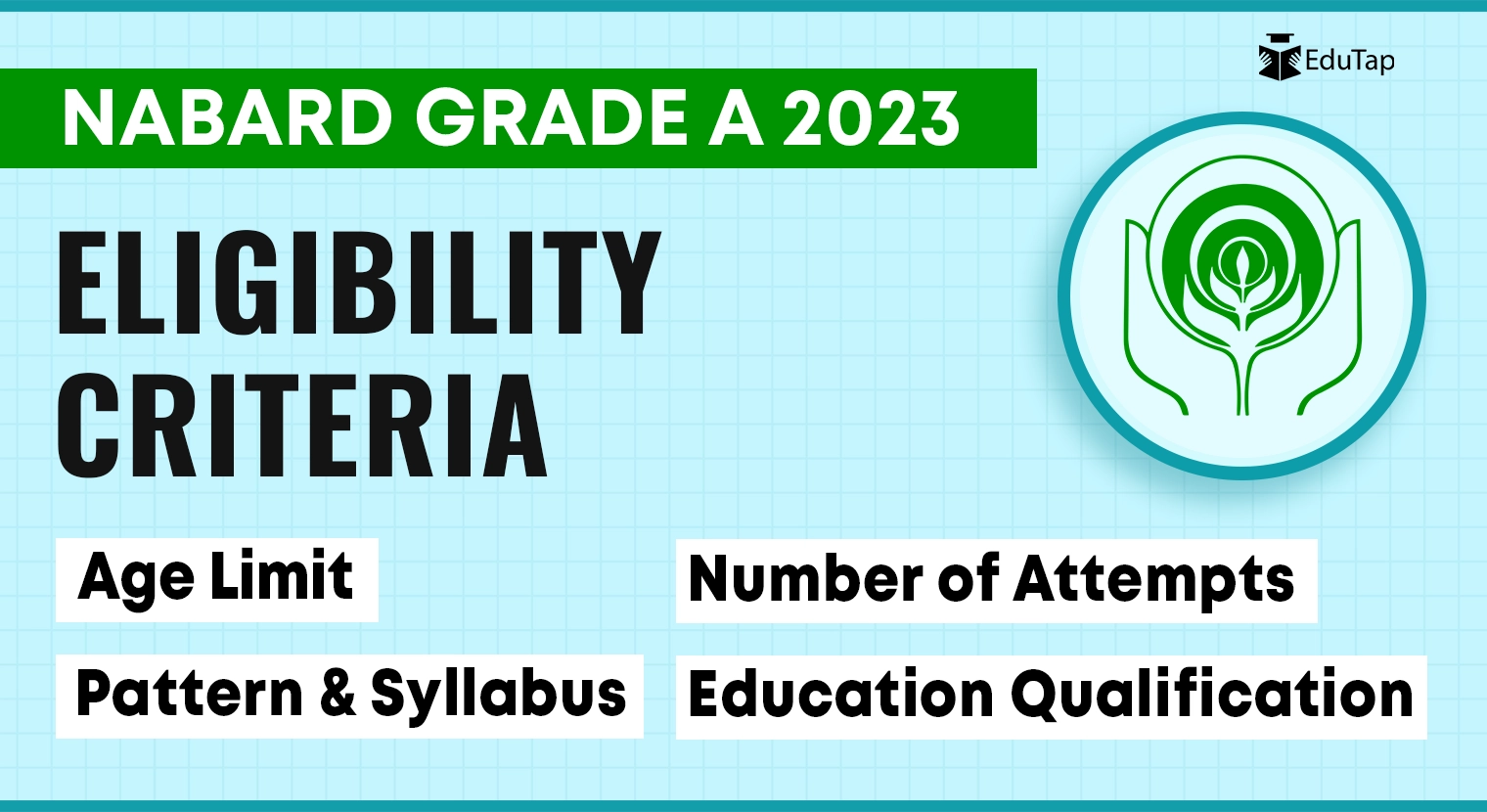The NABARD Grade A phase 2 exam is the second hurdle to becoming an Assistant Manager at NABARD. To clear the mains, aspirants need to know the syllabus, have an idea about the types of questions asked, be able to pinpoint the most important topics under all subjects, and have an effective preparation strategy.
This article will list down the syllabus for the NABARD Grade A 2024 phase 2, the important topics for various subjects, the types of questions you can expect, the difficulty level, and a broad strategy to help you hone your answer writing skills and clear this stage with confidence.
NABARD Grade A Phase 2 Syllabus
The NABARD Grade A Phase 2 (Mains) exam is divided into two papers of 100 marks each.
- Paper I: Descriptive English
- Paper II: Economic and Social Issues (ESI) + Agriculture and Rural Development (ARD)
Let’s review the subject-wise NABARD Grade A phase 2 syllabus, important topics, types of questions, and the overall difficulty level.
Descriptive English Syllabus
The first paper of English aims to assess your writing skills including how well you can express your ideas and also your understanding of the topic of the questions asked.
Following is the syllabus for descriptive English as per the official notification of NABARD.
- Essay
- Précis writing
- Comprehension
- Business/Office Correspondence
What topics do you study to prepare for Paper 1? Let’s find out.
English: Most Important Topics
The English paper of the NABARD exam presents 3 questions (mostly essay, precis, and letter writing) and carries 100 marks in total As a result, selecting important subject topics to focus on is a challenging task.
- The English paper holistically assesses your language proficiency, vocabulary, and topic understanding.
- A well-rounded approach is essential, prioritizing consistent newspaper editorial reading to develop vocabulary and answer typing practice to enhance your writing skills.
To understand why it is difficult to shortlist topics, let’s examine the type of questions candidates can expect for English.
English: Type of Questions
Following are a few questions from the NABARD Grade A 2022 Phase 2 examination.
| Essay Writing | |
| Q1. | Write an Essay of about 300 words on any one of the following topics. (40 Marks) |
| a) | Discuss the issues plaguing the Manufacturing Sector of India. |
| b) | Education is the reason youth are not taking part in Agriculture. Analyse &Review. |
| c) | What would be the better mode of transport for agri–products in India –Road or Rail? |
| d) | Discuss the effects of climate change on biodiversity and wildlife. |
| Precis Writing | |
| Q2. | Make a Précis of the following passage in 120 words and give it a suitable title. (30 Marks) |
| Since the first modern electric vehicles (EVs) took to the roads in the 2000s, critics have been quick to question the ‘clean’ label attached to them. From manufacturing concerns to battery power sources as well as overall autonomy, EVs have been under scrutiny from sceptics. With the amount of debate and misinformation troubling the waters, the facts behind the efficiency of electric vehicles have become somewhat clouded – so just how clean are these vehicles?A comparative study between EVs and internal combustion engine vehicles (ICEV) in China corroborates the ICTT report, indicating that infrastructure and efficient manufacturing techniques are the keys to reducing emissions during production. Chinese EV battery manufacturers produce up to 60% more CO2 during fabrication than ICEV engine production but could cut their emissions by up to 66% if they adopted American or European manufacturing techniques. As such, the pollution created through the extraction process and production of batteries remains on par or slightly higher than the manufacturing process of petrol or diesel-based engines. An electric car at a charging station in Bergen, Norway. This Scandinavian nation has the highest use… [+] of electric cars in the world, and running on mostly hydropower they are also the cleanest. In its study, the ICTT also notes the stark difference in emissions between electric and internal combustion over the course of their lifetimes. With no combustion and complete lack of tailpipe emissions, EVs produce the bulk of their emissions through their manufacturing process and the sourcing of their energy, giving them an advantage over petrol and diesel-powered cars. Whilst ICEVs have been steadily reducing their emissions since 2000, electric vehicles still have a marked edge by producing close to no running emissions. Additionally, as EVs become more common and manufacturing becomes more widespread, battery recycling will be more efficient and reduce the need to extract new materials, therefore lessening the reliance on mining and production of new batteries. The total impact of electric vehicles is more pronounced when looking at their complete lifetime, where combustion engine vehicles are unable to compete. EVs are responsible for considerably lower emissions over their lifetime than vehicles running on fossil fuels, regardless of the source that generates the electricity. A new study by the Center for Economic Studies (CES) in Munich proclaimed: “Germany’s current energy mix and the amount of energy used in battery production, the CO2 emissions of battery-electric vehicles are, in the best case, slightly higher than those of a diesel engine, and are otherwise much higher.”Although it may seem like a damning indictment on electric vehicle performance, the paper was quickly debunked by industry experts, who found a long list of inaccuracies with the CES’s findings. Apart from laying out previously discredited information such as electric car batteries becoming “hazardous waste” after 150,000 km, or misrepresenting government data to fit their research, the study also painted ICEV emissions as lower than the reality. | |
| Letter Writing | |
| Q3. | Write a letter on any one of the topics given below in 150 words. (30 Marks) |
| 1 | Write a letter to your Resident welfare association to review its disaster response procedure. |
| 2 | Write a letter to customer care of an established furniture shop. You bought a piece of furniture which after unboxing was found to be of the wrong size. Write a letter to customer care asking for replacement of the furniture piece bought. |
| 3 | Write a letter to your manager to congratulate him for being promoted and tell him about the role he played in your career. |
Key Takeaways
- Precis and essay topics generally focus on issues related to the ESI and ARD syllabus, be it static or current affairs.
- For letter-writing tasks, you are asked to write to official authorities to address an issue.
- Candidates are advised to read newspaper editorials to build relevant vocabulary and practice answer typing on a keyboard.
Important Note: Paper 2 is a combination of Economic and Social Issues (ESI) and Agriculture and Rural Development (ARD). The paper is 50% objective and 50% descriptive. Here are two points you need to remember about the pattern of Paper 2.
- There are 6 descriptive questions out of which only 4 are to be answered by the candidate (2 questions of 15 marks and 2 questions of 10 marks each).
- There are 30 objective questions of 50 marks in total. Some questions carry 1 mark and some carry 2 marks.
Now, let’s first look at the syllabi for Paper 2 of the NABARD Grade A Phase 2 exam. We will later break down the important topics and types of questions under the objective and descriptive paper sections separately.
Economic and Social Issues (ESI) Syllabus
Following is the complete NABARD Grade A Phase 2 syllabus of ESI as per the official notification of NABARD.
- Nature of Indian Economy – Structural and Institutional features – Economic underdevelopment – Opening up the Indian Economy – Globalisation – Economic Reforms in India – Privatisation. Inflation – Trends in Inflation & their Impact on National Economy and Individual Income.
- Poverty Alleviation and Employment Generation in India – Rural and Urban – Measurement of Poverty – Poverty Alleviation Programmes of the Government.
- Population Trends – Population Growth and Economic Development – Population Policy in India.
- Agriculture – Characteristics / Status – Technical and Institutional changes in Indian Agriculture – Agricultural performance – Issues in Food Security in India – Non-Institutional and Institutional Agencies in rural credit.
- Industry – Industrial and Labour Policy – Industrial performance – Regional Imbalance in India’s Industrial Development – Public Sector Enterprises.
- Rural banking and financial institutions in India – Reforms in Banking/ Financial sector.
- Globalization of Economy – Role of International Funding Institutions – IMF & World Bank – WTO – Regional Economic Co-operation.
- Social Structure in India – Multiculturalism – Demographic trends – Urbanisation and Migration – Gender Issues Joint family system – Social Infrastructure – Education – Health and Environment. Education – Status & System of Education – Socio – Economic Problems associated with Illiteracy – Educational relevance and educational wastage – Educational Policy for India.
- Social Justice: Problems of scheduled castes and scheduled tribes – socio-economic programmes for scheduled castes and scheduled tribes and other backward classes.
- Positive Discrimination in favour of the under privileged – Social Movements -Indian Political Systems – Human Development.
- Current Economic & Social Issues.
Agriculture and Rural Development (ARD) Syllabus
Following is the complete NABARD Grade A Phase 2 syllabus of ARD as per the official notification of NABARD.
Agriculture: definition, meaning and its branches, Agronomy: definition, meaning and scope of agronomy. Classification of field crops. Factors affecting crop production, Agro Climatic Zones; Cropping Systems: Definition and types of cropping systems. Problems of dry land agriculture; Seed production, seed processing, seed village; Meteorology: weather parameters, crop-weather advisory; Precision Farming, System of Crop Intensification, organic farming;
- Soil and Water Conservation: Major soil types, soil fertility, fertilisers, soil erosion, soil conservation, watershed management;
- Water Resource: Irrigation Management: types of irrigation, sources of irrigation, crop-water requirement, command area development, water conservation techniques, micro-irrigation, irrigation pumps, major, medium and minor irrigation.
- Farm and Agri Engineering: Farm Machinery and Power, Sources of power on the farm- human, animal, mechanical, electrical, wind, solar and biomass, bio fuels, water harvesting structures, farm ponds, watershed management, Agro Processing, Controlled and modified storage, perishable food storage, godowns, bins and grain silos.
- Plantation & Horticulture: Definition, meaning and its branches. Agronomic practices and production technology of various plantation and horticulture crops. Post-harvest management, value and supply chain management of Plantation and Horticulture crops.
- Animal Husbandry: Farm animals and their role in Indian economy, Animal husbandry methods in India, common terms pertaining to different species of livestock, Utility classification of breeds of cattle. Introduction to common feeds and fodders, their classification and utility. Introduction to poultry industry in India (past, present and future status), Common terms pertaining to poultry production and management. Concept of mixed farming and its relevance to socio-economic conditions of farmers in India. Complementary and obligatory nature of livestock and poultry production with that of agricultural farming.
- Fisheries: Fisheries resources, management and exploitation – freshwater, brackish water and marine; Aquaculture- Inland and marine; biotechnology; post-harvest technology. Importance of fisheries in India. Common terms pertaining to fish production.
- Forestry: Basic concepts of Forest and Forestry. Principles of silviculture, forest mensuration, forest management and forest economics. Concepts of social forestry, agroforestry, joint forest management. Forest policy and legislation in India, India State of Forest Report 2015. Recent developments under the Ministry of Environment, Forest and Climate Change.
- Agriculture Extensions: Its importance and role, methods of evaluation of extension programmes, Role of Krishi Vigyan Kendra’s (KVK) in dissemination of Agricultural technologies.
- Ecology and Climate Change: Ecology and its relevance to man, natural resources, their sustainable management and conservation. Causes of climate change, Green House Gases (GHG), major GHG emitting countries, climate analysis, distinguish between adaptation and mitigation, climate change impact to agriculture and rural livelihood, carbon credit, IPCC, UNFCCC, CoP meetings, funding mechanisms for climate change projects, initiatives by Govt of India, NAPCC, SAPCC, INDC.
- Present Scenario of Indian Agriculture and Allied activities; recent trends, major challenges in agriculture measures to enhance viability of agriculture. Factors of Production in agriculture; Agricultural Finance and Marketing; Impact of Globalization on Indian Agriculture and issues of Food Security; Concept and Types of Farm Management.
Rural Development: Concept of Rural Area, Structure of the Indian Rural EconomyImportance and role of the rural sector in India- Economic, Social and Demographic Characteristics of the Indian rural economy, causes of Rural Backwardness.
Rural population in India; Occupational structure, Farmers, Agricultural Labourers, Artisans, Handicrafts, Traders, Forest dwellers/tribes and others in rural India- Trends of change in rural population and rural work force; problems and conditions of rural labour; Issues and challenges in Handlooms
Panchayati Raj Institutions – Functions and Working. MGNREGA, NRLM – Aajeevika, Rural Drinking water Programmes, Swachh Bharat, Rural Housing, PURA and other rural development programmes.
Let’s first examine the objective section of Paper 2.
ESI + ARD Objective Section
To help you identify the most important topics for the objective section of Paper 2 of ESI and ARD, here’s an overall analysis of the objective questions of Previous Year Questions for the last few years.
| Number of Questions | ||||||
| S.No. | Topic Name (ESI + ARD) | 2022 | 2021 | 2020 | 2019 | 2018 |
| 1 | Government Schemes | 14 | 12 | 18 | 14 | 8 |
| 2 | Reports/Indices | 0 | 1 | 3 | 10 | 5 |
| 3 | Union Budget/Eco Survey | 2 | 0 | 0 | 5 | 9 |
| 4 | ESI Current Affairs | 0 | 9 | 11 | 11 | 11 |
| 5 | ARD Static | 5 | 5 | 20 | 8 | 9 |
| 6 | ARD Current Affairs | 8 | 1 | 6 | 10 | 20 |
| 7 | ARD Reports | 0 | 2 | 0 | 3 | 1 |
| 8 | ESI Static | 1 | 0 | 7 | 4 | 2 |
| Total Questions | 30 | 30 | 65 | 65 | 65 | |
| Note: Before 2021, Paper II was entirely objective, with 35 – 2 marker questions and 30 – 1 marker questions. Paper II is now divided into 50% objective and 50% descriptive questions. | ||||||
As observed, the weightage of government schemes has remained consistently high throughout the last 5 exam years. Nevertheless, other topics of the Static and Current Affairs syllabus carry a good weightage too.
Let’s now look at the type of objective questions asked to understand the structure of ESI and ARD questions.
ESI: Types of Objective Questions
Following are a few questions from the NABARD Grade A 2022 Phase 2 examination.
| 1 Mark Questions | |
| Topic: Economic Reforms in India (ESI Static) | |
| Q.1 | Which of the following organisations conditionalities were followed in executing the 1991 LPG reforms in India? IMFOPEC member countriesIBRD |
| a) | Only 1 |
| b) | Both 2 & 3 |
| c) | Only 3 |
| d) | All 1, 2, & 3 |
| e) | Both 1 & 3 |
| Topic: Government Schemes (ESI Current Affairs) | |
| Q.2 | Under NFSA, rice is made available at a subsidized price of ______. |
| a) | Rs. 1/kg |
| b) | Rs. 2/kg |
| c) | Rs. 3/kg |
| d) | Rs. 4/kg |
| e) | Rs. 5/kg |
| 2 Marks Questions | |
| Topic: Economic Survey (ESI Current Affairs) | |
| Q.4 | As per the Economic Survey 2021-22, the existing cropping pattern is skewed towards the cultivation of ____________ which has led to the depletion of fresh groundwater resources at alarming rates. |
| a) | Sugarcane, Paddy, and Cotton |
| b) | Pulses, Paddy, and Wheat |
| c) | Sugarcane, Cotton, and Wheat |
| d) | Sugarcane, Paddy, and Wheat |
| e) | Sugarcane, Paddy, and Pulses |
| Topic: Government Schemes (ESI Current Affairs) | |
| Q. | Which of the following statements is correct with regard to the outcomes of the scheme?Statements:Zero fatalities in sanitation work in India.All sanitation work is to be performed by skilled workers.Strengthened supervisory and monitoring systems only at the state level to ensure enforcement and monitoring of safe sanitation work. |
| a) | Only 1 |
| b) | Both 2 & 3 |
| c) | Only 3 |
| d) | All 1, 2, & 3 |
| e) | Both 1 & 2 |
ARD: Types of Objective Questions
Following are a few questions from the NABARD Grade A 2022 Phase 2 examination.
| 1 Mark Questions | |
| Topic: Forestry (ARD Static) | |
| Q.1 | When a farmer cultivates perennial trees for commercial purposes alongside the cultivation of crops for subsistence. This type of forestry is known as _______. |
| a) | Progressive Forestry |
| b) | Productive Forestry |
| c) | Subsistence Forestry |
| d) | Commercial Forestry |
| e) | None of the above |
| Topic: NABARD Annual Report (ARD Current Affairs) | |
| Q.3 | What is the name of the subsidiary of NABARD which encourages to invest in rural areas and cooperation? |
| a) | NABVENTURE |
| b) | NaBFID |
| c) | NABCON |
| d) | NABSAMRUDDHI |
| e) | NABKISAN |
| 2 Marks Questions | |
| Topic: Animal Husbandry & Poultry (ARD Static) | |
| Q.3 | PASSAGE ON “Swine Breeding”Passage: Both domestic, standard breed, and miniature breeds of swine have a gestation period of 112–120 days. When piglets are born between 109 and 112 days of gestation, it’s premature ___________. During the gestating time, the piglets go through different phases of development, which we will separate into 5 major phases. Swine can give birth from one to even 20 or more piglets. The most obvious sign that a sow is pregnant is that she doesn’t go into heat after an appropriate number of days.Q. What is the gestation period of Swine? |
| a) | 125 days |
| b) | 114 days |
| c) | 150 days |
| d) | 96 days |
| e) | 102 days |
| Topic: Farming System (ARD Current Affairs) | |
| Q.4 | The government has finalized an ______ framework which would lay down the architecture for the federated farmers’ database being built by taking the publicly available data as existing in various schemes and linking them with the digitized land records. |
| a) | IDEA |
| b) | DARE |
| c) | SAFE |
| d) | CARE |
| e) | None of the above |
Key Takeaways
- Expect questions from the core topics in the ESI and ARD static syllabus, prioritizing current affairs.
- Some questions can be related to both ESI and ARD as it is a combined paper. Give both subjects equal importance in your preparation.
- Solve a good number of test series and mock tests on the EduTap platform.
Let us now understand the descriptive section of Paper 2 by examining the types of questions asked.
Note: Similar to descriptive English, the questions for the descriptive section of ESI and ARD can range from the entirety of the given syllabus. Hence, it is difficult to identify specific important topics.
ESI + ARD Types of Descriptive Questions
Following are a few questions from the NABARD Grade A 2023 Phase 2 examination.
| S.No. | Questions | Marks | Topic | Subject |
| 1 | What is social forestry? What are the objectives of social forestry? What are the various facets of social forestry and list some economic benefits? | 10 | Forestry | ARD Static |
| 2 | What are the key objectives of the National Rural Livelihoods Mission? What are its features and components? | 10 | Schemes | ARD Static |
| 3 | How globalization has benefited the Indian Economy? (Compulsory) | 10 | Economy of India | ESI Static + Current |
| 4 | PDS plays a crucial part in the Food Economy, however, there are certain lacunae in it. Discuss. | 15 | Issues related to Food Security | ESI Static + Current |
| 5 | Investment in Social Infrastructure is a prerequisite for inclusive growth.” Discuss this in Indian Context. | 15 | Inclusive Growth | ESI Static + Current |
| 6 | Discuss the objectives of Pradhan Mantri Matsya Sampada Yojana (PMMSY). Also, highlight the important initiatives under this scheme. (Compulsory) | 15 | Fisheries (Schemes) | ARD Static |
Key Takeaways
- Focus on developing a deep understanding of the fundamental topics covered in the ARD and ESI. Pay close attention to the syllabus and make sure you have a strong grasp of the topics.
- Be prepared to answer questions that combine both static knowledge and current events under ESI and ARD. Develop a holistic learning strategy, rather than just memorizing facts.
To ease your mind and preparation, we have listed the core topics from the syllabus of ESI and ARD.
ESI + ARD: Most Important Topics
Following is a list of essential core topics for ESI and ARD from the syllabus given by NABARD that you must cover for Phase 2. We have also included Current Affairs topics that you need to prioritise.
ARD: Important Topics
- Agronomy: Production, Definition, & Meaning
- Farming System: Types of Farming
- Types of Soils and Soil Water
- Methods to prevent soil erosion
- Nutrient deficiency and symptoms
- Horticulture: Production and Branches
- Vegetative Propagation and Types
- Major Disease and Pest
- Post-harvest method
- Animal Husbandry: Breeds, Terminology
- Milks and its properties
- Poultry: Breed and Terminology
- Fisheries: Types and Production
- Aquaculture: Breeds, types, and terminology
- Forestry and Types
- Agriculture Extension Institute and Schemes
ARD Current Affairs
- ARD Schemes of the latest 6 months
- Flagship Agriculture Schemes (AIF, PMKSY, PMFBY, PM-KMY, e-NAM, KCC, SHC, PMMSY, NHM)
- Flagship Rural Development Schemes: PMAY-G, PMGSY, NRuM, MGNREGA, JJM, NRLM, DDUGKY
- Census: 2011, SECC, Livestock, Agriculture
- Annual Reports: MoA&FW, AH&D, NABARD, and MSP
- Latest Union Budget
- Latest Economic Survey
- Indian State of Forest Report
- Key Stats of Cooperative Banks
ESI: Important Topics
- Growth and Development
- Poverty Alleviation and Employment Generation in India
- Economic History of India – Globalisation and Privatisation
- Sustainable Development and Environmental Issues.
- Fiscal Policy + Monetary Policy
- Inflation
- Industrial & Labour Policy
- Indian Agriculture
- Regional Economic Cooperation
- International Economic Institutions – IMF and World Bank – WTO
- Opening up of the Indian Economy, Balance of Payments
- Multiculturalism
- Population and Demographic Trends
- Urbanisation and Migration
- Gender Issues
- Social Justice- Positive Discrimination in favour of the underprivileged
- Social Movements
- Indian Political System
- Human Development
- Social Sectors in India, Health and Education
- Rural banking and Financial Institutions – Reforms in Banking and Financial Sector
ESI Current Affairs
- Flagship Economic Development Schemes: PM-SYM, PMJDY, PMJJBY, PMSBY, PMMY, Stand Up India, DDU-GKY, PMEGP, Production-Linked Incentive (PLI) Scheme
- Reports: Economic Survey, Union Budget, Census, SECC (latest version)
- Data by Important Institutes: NITI Ayog, RBI, NABARD, WTO, WB, IMF, ADB, etc (latest version)
- MoUs + Funding, Banks, Alliance, Membership
- Ranking: India and the Indian States
- First in News (For ex: an initiative taken for the first time, a national organisation’s first event, etc.)
- Current Affairs related to ESI Static topics: Economics (such as GDP), Growth Projections, Monetary and Fiscal Policy (Repo Rates), and Social Issues (such as meetings related to Poverty, Gender Bias, Human Development, Education, and Health)
Kindly note that the above list of important topics is solely to help you streamline your preparation and make it more efficient. It does not indicate that you should skip the rest of the syllabus.
By now we have covered a few questions from the NABARD Grade A 2023 Phase 2 exam. However, we recommend that you examine the PYQs from the last 5 years in-depth.
NABARD Grade A Previous Year’s Questions PDF Download
Download EduTap’s FREE PYQ Analysis PDFs to get a deep dive into past NABARD Grade A Phase 2 exams. These PDFs provide solutions to asked questions and break down question topics respectively. Start with the 2018 exam and study your way up to the latest one.
A comprehensive examination of the PYQs can help you familiarize yourself with the types of questions that will be asked, and the subject topics you need to focus on, identify your strong areas as well as areas where you need to improve, and subsequently develop effective strategies.
Now that you have access to the PYQs, let’s understand the difficulty level of the NABARD Grade A Phase 2.
NABARD Phase 2 Difficulty Level
The difficulty level of the NABARD Grade A Phase 2 exam is moderate, with a few challenging questions. But, it is possible to crack the exam with proper preparation.
Here are a few tips to help you tackle the difficulty level for both objective and descriptive questions of Phase 2 with ease.
- Utilize online resources and free study material such as mock tests, practice questions, and video tutorials to supplement your preparation.
- Dedicate time each day to practice writing answers to various types of questions under timed conditions. Stick to typing on a keyboard only. Use tools such as Grammarly for grammatical errors.
- Enroll in a test series to assess your preparation level, identify areas for improvement, and gain exposure to the exam pattern.
- Familiarise yourself with the exam pattern, including time allocation, question types, and marking scheme, to optimize your exam preparation strategy.
NABARD Grade A 2024 Phase 2 Preparation Strategy
The Phase 2 Mains exam comprises objective and descriptive questions. While objective skills can be honed through a comprehensive syllabus study combined with consistent mock tests to evaluate your preparation, answer writing practice is crucial for clearing Paper 1 and 2.
Here’s a list of important topics to kickstart your answer writing journey.
English Essay Writing Practice
Following is a list of important topics that you should practice for descriptive English.
- Urban Farming, related challenges, and its potential.
- Rising population: A demographic dividend or disaster for India?
- Rising Heatwave and its impact
- Green Growth: Important, Challenges, Initiatives
- Growing startup culture in India
- Electric Vehicle: The Future of Transport
- Artificial Intelligence and its Role in Education
- “Peace can be established by understanding and not by force.”
- Role of renewable energy in the fight against climate change
- The need of the hour is to maximize the possibilities of agriculture in India
- Role of technology in agrarian changes
ESI Answer Writing Practice
Following is a list of important topics that you should practice for descriptive ESI.
- What are the tools for Monetary Policy?
- Explain the significance & effects of LPG Reforms in India.
- What is Inflation? Explain its types and target for RBI.
- Explain unemployment and its types.
- Write in detail about the important International Economics Institutions.
- What is the Balance of payment and its accounts?
- Discuss the important components of the Union Budget.
- Explain what inclusive growth is. How is it different from Inclusive development?
- What is the Human Development Index? Explain its dimensions and Indicators.
- Discuss Urbanization and associated phenomena.
ARD Answer Writing Practice
Following is a list of important topics that you should practice for ARD.
- Explain MSP and how it supports small and marginal farmers.
- What is Agroforestry? Explain its types, objectives, and advantages.
- Organic farming has changed the way of agriculture in India. Discuss organic farming.
- What is soil erosion? Discuss various methods for its prevention.
- Explain the methods of vegetative propagation. What are the various facets of vegetative propagation and list some benefits.
- Micro-irrigation is the future method of irrigation. Discuss.
- Explain various housing systems in poultry.
- What is Aquaculture? Explain various types of aquaculture practiced in India.
- Discuss the evolution of the Panchayati Raj System in India.
- Fruits and vegetables have a very short shelf life. However, various post-harvest techniques are used to enhance it. Discuss these techniques.
We hope that the given information will help you get started on developing your preparation strategy for the NABARD Grade A 2024 Phase 2 exam.
Conclusion
In this article, we have listed the complete NABARD Grade A Manager Phase 2 syllabus, examined the types of questions, discussed important topics, and the overall expected difficulty level for the exam. We have also provided a list of topics to help you ace descriptive writing for English, ESI, and ARD.
Remember, to prepare effectively, you should understand the syllabus and exam pattern thoroughly, identify your strengths and weaknesses, create a study plan and stick to it, use quality study materials, solve previous year question papers and mock tests, and practice answer writing consistently.
Note: To learn about the NABARD Grade A 2024 Phase 1 syllabus, types of questions, expected difficulty, and the best preparation strategy, click here.
FAQs
There is sectional timing for NABARD Grade A Phase 2 Mains Exam. Candidates get 90 minutes for Paper 1 (English) and 120 minutes for Paper 2 (ESI + ARD).
For the preparation of NABARD Grade A 2024, EduTap offers a 15-day free starter pack for beginners. It’s a comprehensive resource created by experienced teachers to help you prepare effectively. This course includes videos on different subjects, study notes, practice tests, and more. It also covers detailed content for ESI and ARD in line with the latest pattern.
Based on our expert analysis of the trends of the last 3 years, the notification is expected at the end of August or the beginning of September 2024.
No. PYQs are meant to be a guide that helps you develop an idea of what to expect. Taking mock tests and appearing for test series based on the latest pattern and syllabus is essential for a competitive exam like NABARD Grade A.





